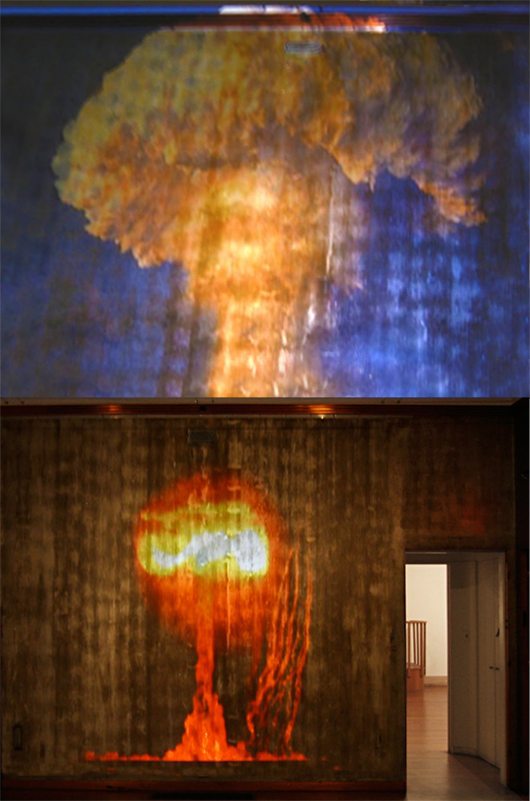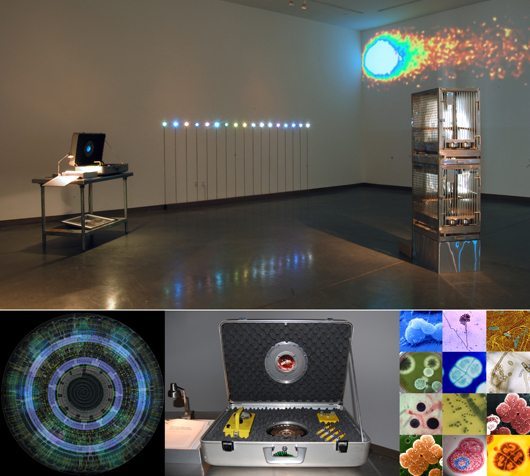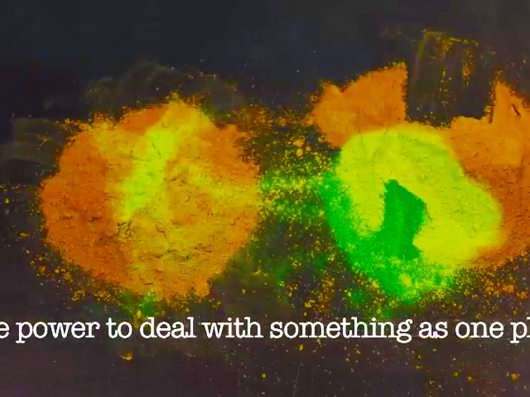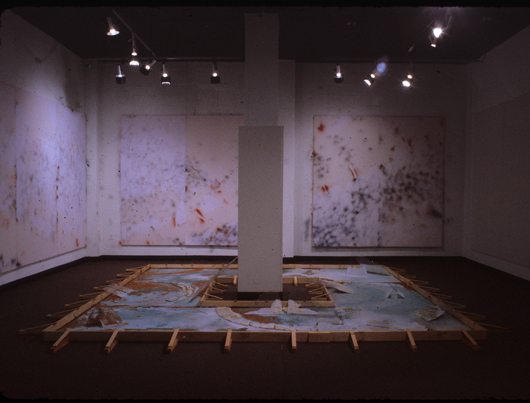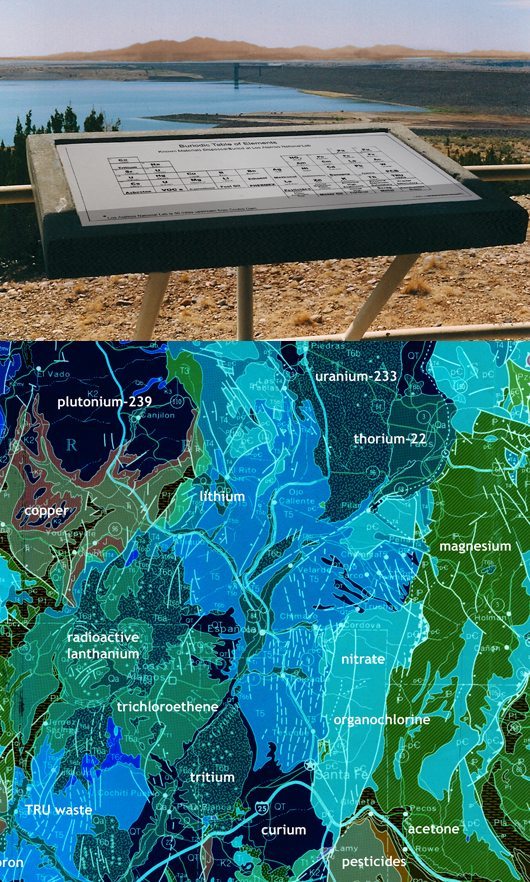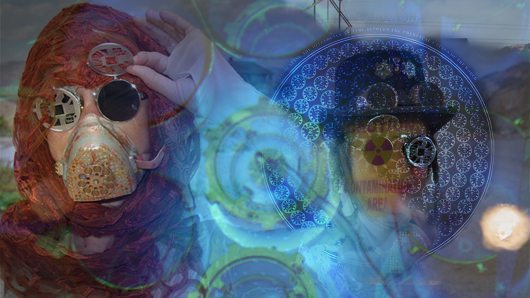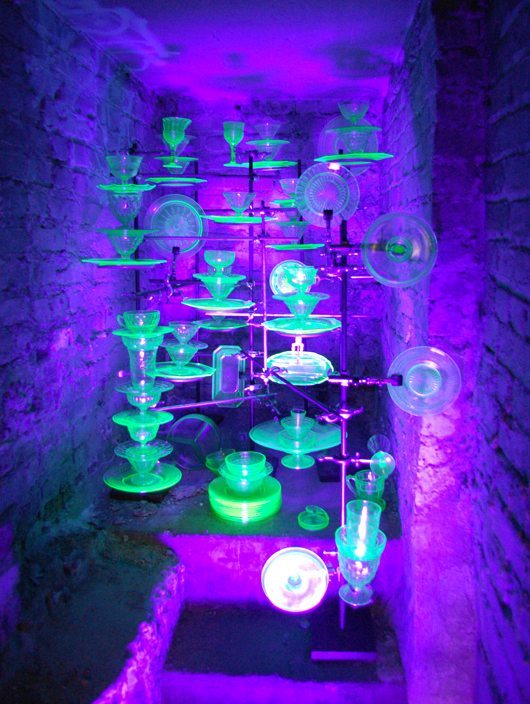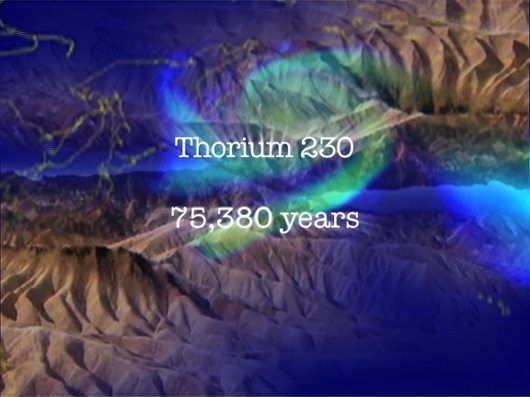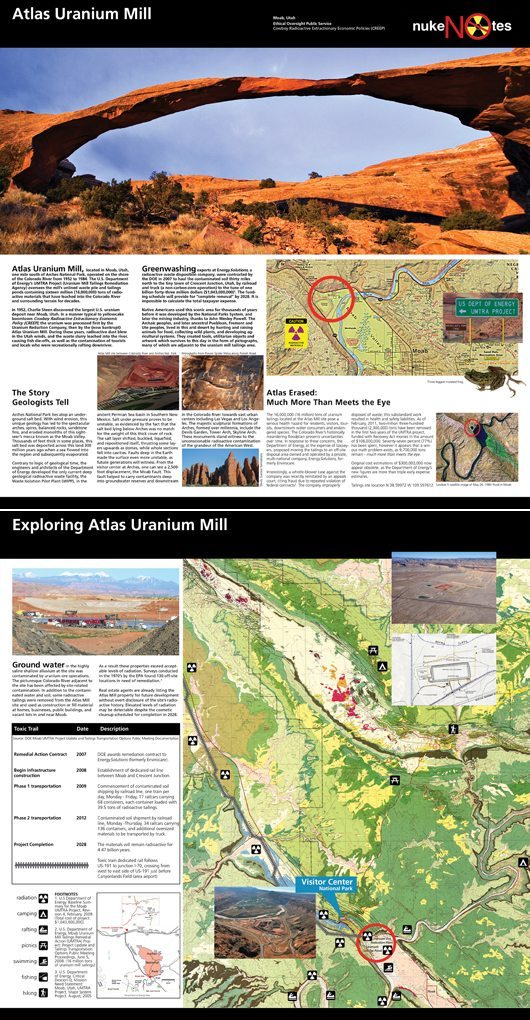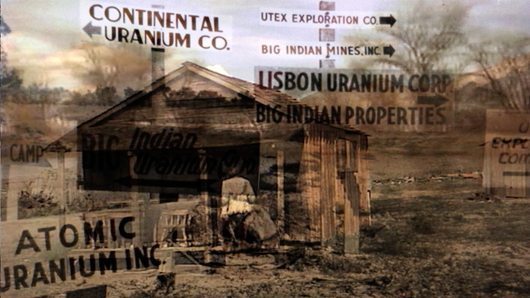Title: Tracking Our Atomic Legacy:
Now We Are All Sons of Bitches‘Now we are all sons of bitches.’
– Test director Kenneth Bainbridge to J. Robert Oppenheimer, while watching the first atomic bomb test
‘It is dark disaster that brings the light.’
– Maurice Blanchot, The Writing of the Disaster
I. ARCHIVE
THROUGH TRACKING THE INVISIBLE TRACES left behind by the nuclear weapons complex and its ‘peaceful’ doppelganger, the nuclear energy industry, my visual artwork forms an archive of our shared atomic legacy. Radioactive waste is never disposed of; it is dispositioned – placed out of sight and out of mind. By visualizing this contamination through installations, videos, images and social-sculpture interventions, I shape this content by sharing information, raising awareness, and activating community participation in remediation and nonproliferation efforts. In dozens of field trips over the past 20 years I have met with retired miners, hydrologists, geologists and remediation engineers at numerous abandoned uranium mines and mills including the Jackpile Uranium Mine, formerly the world’s largest open-pit uranium mine. I have also visited numerous atomic age historical sites and attended the 2006 International Peace Conference in Hiroshima. By accessing and utilizing public information from the Department of Energy (DOE) and other public governmental and NGO databases, I scrutinize data, maps and statistics, providing empowerment to support this work. Awareness of the spatial history of our Atomic Age legacy sharpens our ethics and politics in our behaviors and social interactions.
Growing up in Los Angeles during the Cold War, I was sensitized to ‘Atomic Age’ issues from years of weekly Civil Defense duck-and-cover drills, sonic booms, and air-raid warning sirens. John Hershey’s book, Hiroshima, was required reading in high school. Like thousands, perhaps even millions of other children of my generation, I had recurring nightmares about nuclear war.
The explosive atomic attack on Japan in 1945, has given way to an implosive global ecological war beyond national territories: contaminating water, polluting the land, infiltrating the air – and the cells of bodies. We are still engaged in nuclear war through the use of depleted uranium weapons in Iraq, and the on-going development of new strategic nuclear weapons. The Chernobyl and Fukushima meltdowns are evidence of the nuclear power industry and their government cronies waging war against life.
Fall 1978. When I was in graduate school, the artist/filmmaker Bruce Connor was frequently seen slinking around the San Francisco Art Institute or Mabuhay Gardens with his camera, making photos for the punkzine, Search and Destroy. He was a mercurial in-between figure not a student, not a teacher – a silent shadowy presence. On several occasions I saw his film, Crossroads (1976), incorporating appropriated footage from nuclear bomb testing at Bikini Atoll in the Pacific Ocean. For thirty-six minutes, take after black-and-white take, the spectator is suspended in time and space; forced to deal with the (sur)reality and overwhelming power of the bomb. My eyes zeroing-in on the screen, it became evident that the greatest human catastrophe of the 20th Century was simultaneously one of the ‘greatest’ photographic and cinematic events. Connor’s work taught me that art can be simultaneously poetic and political — that beauty can be subversive.
II. INVISIBILITY
‘There is a visible in the in-visible, an invisible order of the visible that I can keep secret by keeping out of sight. If I had a nuclear arsenal in underground silos or hide explosives in a cache, there is a visible surface involved whatever one conceals in this way becomes invisible but remains within the order of visibility.’
– Jacques Derrida, The Gift of Death
DERRIDA DEFINES “ABSOLUTE INVISIBILITY” as standing outside of range and register of visual perception; phenomena that can only be perceived through the other senses or detected by other means. It is absolutely outside vision, and thus, secret.
I address this nonvisibility of radiation as ‘secret visibility’ in the installation, Halfway to Invisible, (2009) commissioned by Emory University Center for Creativity. Because of Emory’s proximity to the Center for Disease Control, I chose the CDC as the intended audience by focusing on the epidemiological and genetic/biological impact of uranium mining in the American Southwest. Between 1949 and 1989, these mines produced more than 225,000,000 tons of uranium ore. This activity affected a large number of Native American nations, including the Laguna, Navajo, Zuni, Southern Ute, Ute Mountain, Hopi, Acoma and other Pueblo cultures. Many of these peoples worked in the 4,000 mines, mills and processing plants in New Mexico, Arizona, Utah and Colorado. These workers were not only poorly paid, they were seldom informed of dangers nor were they given appropriate protective gear. The government, mine owners, scientific, and health communities were all well aware of the hazards of working with radioactive materials at this time.
Due to the Cold War demand for increasingly destructive and powerful nuclear weapons, these laborers were both exposed to and brought home large amounts of radiation in the form of dust on their clothing and skin. Epidemiologic studies of the families of these workers have shown increased incidents of radiation-induced cancers, miscarriages, cleft palates and other birth defects. Halfway to Invisible questions how these events may have influenced evolutionary processes and produced genetic casualties in these communities. Is our atomic legacy producing genotoxic effects in indigenous human populations? If so, what is the extent of DNA damage, and how might this affect these populations in the future?
The installation includes sixty small light-boxes containing photographic transparencies of radial gene maps and cancer cells with superimposed text, as well as micro-photographs of extremophile organisms currently under study as bioremediation agents for radioactive waste. A viewer-activated kinetic sculpture made from laboratory animal cages, a video sculpture interpretation of genetic mutation housed in a Haliburton case containing Cold War era artifacts, and a video projection of genetic material breaking off from a cell immersed in a solution of uranyl acetate.
III. DISPOSITION
Disposition
– A person’s inherent qualities of mind and character
– An inclination or tendency
– The action of arranging or ordering people or things in a particular way
– Military preparations, in particular the stationing of troops ready for attack or defense
– The action of distributing or transferring property or money to another
– The power to deal with something as one pleases
SEPTEMBER 2010. I TURN MY DUST COVERED car into the immense parking lot of a faux Mediterranean resort hotel in Las Vegas. Walking past artificial rock fountains I enter the casino-conference center to attend the Annual International RadWaste Summit. The conference is from the perspective of the producers of that waste, e.g. nuclear industry boosters and various government agencies including DOE, DOD, ACoE, EPA, NRC, IAEA, NEI, and others. The subject is the ongoing flow of radioactive waste. The men are handsome, tanned and tall and fit in cowboy boots and jeans or black loafers and khakis; the women are handsome too, well groomed in business suits with heels and confident voices. It is obvious that I am an outsider however hard I try to look default normal camouflaged in a black dress and taupe jacket.
This is a group of insiders, with only a handful of ‘anti’s’ in attendance. I am here to gather information and hear their stories, to learn their language of acronyms to better decipher the codified statistics available to the public. I notice attendees use the word disposition in place of ‘disposal.’
Disposition is a fluid situation not a fixed or final resting place. It is an approximate proximity of traces, a distribution of particles weaving together fields of radiotoxic matter through geological time and space. Shifty extractionary interventions, milling ore into powder, stealth accumulative procedures, unseen aggregations and invisible releases, deployed through military/industrial modes of production and distribution, supported by cronyistic economic complexes.
Dispositions are temporary locations involving multiple sites and confluences of flows, they represent and embody temporary collocations of matter, environmental attitudes and values. Suspended in this turbulence we find millions of particles, some colliding, others softly slipping past one another, slipping through holes in the system. Millions of tons of contaminated earth and billions of gallons of radioactive fluids comprise these complex fields of toxicity. Isotopes moving through strata and time result in cancer clusters throughout the world.
Dispositioned traces of glowing matter slip into our cells, into the spaces between our bodies, into our selves.
IV. SPILL
‘Since things and my body are made of the same stuff, vision must take place in them; their manifest visibility must be repeated in the body by a secret visibility.’ – Maurice Merleau-Ponty, The Primacy of Perception
JUNE 1980. I MOVE FROM CALIFORNIA TO New Mexico. On July 17, the Albuquerque Journal publishes an exposé on the United Nuclear Corporation’s Church Rock Uranium Mill Tailings Pond Spill. The breach occurred one year earlier, on July 16, 1979, exactly 34 years after ‘The Gadget’ was detonated at the Trinity Site in New Mexico. The UNC spill was the largest release of radioactive toxins in recorded U.S. history occurring just fourteen weeks after the Three Mile Island (TMI) nuclear power plant meltdown near Harrisburg, PA, spilling significantly more radioactive materials on land and in water than TMI. But few Americans are aware of the New Mexico event, perhaps due to its location on ‘remote indigenous lands’.
As I read the newspaper in horror, I learn that radioactive tailings leaked into the Rio Puerco and that Navajo women who herded their sheep across the shallow river developed sores on their legs that would not heal: radiation burns. Later, babies were born with birth defects; then cancer clusters developed in nearby communities. My anger and unwillingness to tolerate this injustice activated my work, and I began zeroing-in on radioactive issues and atomic legacy sites where uranium mining/milling, plutonium production for nuclear weapons and the nuclear energy industry have contaminated water and land.
To make these complex unseen issues accessible to the public, I created the installations, Capillary Action (1982) Notes from the Nuke Farm (1982); Spill Colony (1986) and Circular Waves on Water: Fermi’s Eyes (1988).
V. ACTIVATION
1984. DUANE GRIFFIN AND I FOUND ART/MEDIA, an arts organization and multi-faceted social sculpture, deploying non-traditional means to distribute political art. The project reaches a broad and diverse audience. I become the executive director, and Ann Zimmerman joins as co-director. As performative activist-artists, we go by the pseudonym, The Carcass Sisters. ART/MEDIA invites local and nationally known artists to create socio-political artwork in the mass media: billboards on the interstate highways and along the Route 66 corridor, sound works on radio, short videos in the form of ‘public service announcements’ on television, printed works in newspapers and magazines. These are supported by a performance art series, exhibitions and lecture series. Hans Haacke, Jenny Holzer, Rachel Rosenthal, Terry Allen, Craig Owens, Godfrey Reggio and other artists, poets, performers and critics create works and presentations in response to – and in collaboration with – local artists on subjects ranging from nuclear proliferation, environmental degradation, human and animal rights. Pioneer video artists Steina and Woody Vasulka document the project. (1)
VI. ACCIDENT
IN HIS ESSAY, UNKNOWN QUANTITY, PAUL VIRILIO proposes a Major Accident Museum, not to spread fear but to definitively admit that accidents are cumulative realities not chance events. Exposing and exhibiting the accident, catastrophe or disaster, we are made aware of the indirect production of science and techno-science, as a responsibility to future generations. We can begin to do so by overcoming our cultural anxiety and denial of the hazards of that invisible ‘unknown quantity’: radioactivity.
1957-1964, thirty miles north of Los Angeles, Rocketdyne operates a fleet of ten experimental nuclear reactors at the Santa Susanna Field Lab where numerous accidents including a core meltdown occur. Because these reactors were considered ‘experimental’ none of them had the type of containment structures that shield modern nuclear reactors.
A series of events are covered up by the Department of Energy — 1957: a fire raged out of control in the Hot Lab leading to ‘massive contamination.’ 1959: the AE6 reactor released fission gasses, later that year the SRE facility suffered a partial nuclear reactor core meltdown, releasing 459 times the radiation as TMI. 1964: 80% of the SNAP8-ER reactor’s fuel was damaged. 1969: the SNAP8-DR reactor lost one third of its fuel. 1971: a radioactive fire broke out from the combustion of sodium reactor coolant that had been contaminated with fission products. Eight years later, in 1979, Rocketdyne publicly admits to these events.
Finally, in 1999 the site was ‘properly cleaned up’ although to this day, thousands of pounds of contaminated sodium coolant are still unaccounted for. In 2005, forty five years after the meltdown, local residents filed a class-action suit and were awarded $30 million dollars in damages, although many victims of the environmental catastrophe were already deceased.
VII. WASTE
FLUID GEOGRAPHIES (2001-2004), INVESTIGATES the environmental legacy of the research and development of atomic weapons in Northern New Mexico. Los Alamos National Laboratories (LANL), the ‘birthplace’ of the atomic bomb, is situated atop Pajarito Plateau, nineteen miles northwest of Santa Fe. The lab property is divided by several arroyos that flow into the Rio Grande. During the Manhattan Project and the following Cold War years, more than 17,500,000 cubic feet of radioactive and other toxic wastes were buried in cardboard boxes, plastic containers and steel drums directly in the ground and arroyos surrounding the labs. In 1994 plutonium (one of the deadliest substances known to humankind) was detected in the Rio Grande. Since 2000, other radioactive isotopes were detected in the drinking water, ground water and deep aquifer water including strontium-90, tritium, polonium, uranium, technicium, among others. The rate of brain, nervous system and thyroid cancers are considerably higher in this region than in other state and national reference populations. The problem continues to this day, and there is no known solution.
The installation is comprised of digital prints, maps, photographs, an archive of documents, a video projection on a gold leafed wall, a poetic text, and mirrors engraved with a list of 55 known contaminants buried at Los Alamos.
A correlative community action/social sculpture took place at the Cochiti Lake Scenic Overlook, downstream from LANL. A map of the Los Alamos watershed marked with the LANL Material Disposal Areas, and a chart of known contaminants buried at Los Alamos was inserted in the ‘scenic overlook’ plaque holders. My collaborative team and I, under the auspices of LANL: Lost Artists in Nuclear Landscapes, spoke with tourists about radioactive water contamination.(2)
Later that week, the artist Julie Miller and I were photographing signage from a public highway through LANL, our vehicle was surrounded by five armed guards who questioned us for several hours, threatening us with arrest for committing a ‘federal offense’ only to later send us away informing us that photography of signage from the road was in fact not illegal.
VIII. FICTION SCIENCE
Every discipline creates its own illusion and hides behind its own smokescreen.
— Deleuze & Guattari, Difference and Repetition
SIXTY-SEVEN YEARS HAVE PASSED SINCE the first nuclear weapon was detonated at the Trinity site in the New Mexico desert, and 60 years since the nuclear ‘energy’ industry metastacized from the military. The fact that no long-term plan exists for RadWaste disposal is proof enough that the concept and the science is flawed. In addition to massive quantities of military waste, 71,862 tons of commercial nuclear waste sits in temporary storage. The 2012 Blue Ribbon Commission Report on America’s Nuclear Future states, ‘this nation’s failure to come to grips with the nuclear waste issue has already proved damaging and costly.’ It is interesting that it does not state it is, more significantly, deadly.
To shift the way we look at complex, perhaps unsolvable environmental problems I cast a series of fictional characters in Slouching Towards Yucca Mountain (2011-2012). These time-travelers explore the landscape of the post-atomic West. A decade ago the U.S. government began developing Yucca Mountain in Nevada as a deep geological repository for high-level radioactive waste. Due to geological faults and climate uncertainties the repository project was terminated. However, a seven-mile long maze of excavated tunnels exist at the site beneath the mountain. Because there is no master plan for permanent disposal, waste sits in temporary storage at hundreds of sites across the country. Slouching is set in an ambiguous time period, spanning three centuries. It consists of a non-linear narrative that plays out in abandoned tunnels and ’empty wastelands’ of southern Nevada and Death Valley, California. Cowboy extractionary economics are explored using tropes and clichés of the Western and science fiction film genres so that a subtext of environmental exposé develops. With a mixture of humor and dead seriousness the project reveals American values and beliefs about nature, conquest, and environmental justice. Project collaborators are Courtney ‘scrapworm’ Wrenn, Chelsea Noggle, Michel Tallichet, Emily ‘DJ Dirtgirl’ Montoya and Benji Geary. (3)
VIII. DISAPPEARANCE
‘ a shadow without a body, a residue of corporality that stains the invisible body. A shadow of invisibility, and invisibility as shadow.’ – Akira Mizuta Lippit, Atomic Light (Shadow Optics)
EXPOSURE TO RADIATION POSES DISPROPORTIONATE risk for women and children. The National Academy of Sciences report, Biological Effects of Ionizing Radiation, discloses that no ‘safe dose’ of ionizing radiation exists, and that women have 40-60% greater likelihood of developing fatal cancers, children are more vulnerable than adults, and girls are twice as likely to develop cancer than boys. But all life forms are at risk, not just human beings. Radiation from weapons testing and ongoing release from Fukushima present internal exposures because radiation tends to bioaccumulate up the food chain. The true costs of ‘clean green cheap’ nuclear energy must take into account the front end and back end of the fuel process, and the cost to the health of all species due to accidents.
‘Hundreds of thousands of military personnel and civilians in the United States received significant radiation doses as a result of their participation in nuclear weapons testing and supporting occupations and industries, including nuclear fuel and weapons production, and uranium mining, milling, and ore transport. Hundreds of thousands more were irradiated at levels sufficient to cause cancer and other diseases. These populations include the families of military and civilan workers, and people – known as ‘downwinders’ – living or working in communities surrounding or downstream from testing and related activities, and in relatively distant areas to which nuclear fallout or other radioactive material spread. Federal responses to the plight of affected individuals have been unsatisfactory.’ — 2008-9 NCI report of the US DHHS
National Cancer Institute/U.S. Department of Health reports that exposure to radiation from nuclear weapons testing is a worldwide issue of significant concern. Many governments, including our own, have long denied that the magnitude of cancers and other radiation-related diseases has kept many of those affected from receiving necessary care. We are all affected – strontium-90 from weapons testing is in our teeth and bones, cesium-137 from Fukushima is in our tissues. Radiation does not stop at international borders. Each and every weapons test and nuclear accident is recorded in the ice of Antarctica – scientists have monitored these traces in ice core samples. We all are test subjects of the Atomic Age.
Invisible Fire (2012), is an installation of repurposed Depression glass that fluoresces under ultraviolet light due to the use of uranium oxide as a colorant. Depression glass production sharply curtailed during the Cold War and has since become a ‘collectible.’ The green glass also references trinitite, an anthropogenic mineral; the glassy residue produced during nuclear weapon tests, by melting and fusing the silica in desert sand into a radioactive green glass.
Fernald Greenwash (2011), a collaboration with computer scientist Kalyan Chakravarthy Thokala, visualizes ground water contaminated with radioactive isotopes at the site of the former Fernald Uranium Feed Material Production Plant near Cincinatti, Ohio. It has since been ‘transformed’ into the Fernald Ecological Park. The Department of Energy estimates that 1.2 million cubic meters of soil and 237 million cubic meters of water were contaminated. The underground plume is 1.5 miles long by 1.8 miles wide extending far beyond the facility into the Great Miami Aquifer. Fernald was the largest producer of uranium metal for nuclear weapons production and also received radioactive wastes from the Manhattan Project.
Using OpenGL and GoogleEarth, water sample data was collected from 474 wells from the DOE Office of Legacy Management Geospatial Environmental Mapping System, visualizing underground zones where plutonium, uranium, radium, technitium, and thorium are present in the ground water. The second phase of the project will involve collaborating with a hydrologist and GIS specialist to create a ‘deep map’ taking into consideration climate change and how radionuclides persist in the environment for thousands of years.
Uranium Decay (2012), draws attention to the dark, inverse form of alchemy of the Atomic Age. Responding to the ongoing Fukushima meltdowns the video illuminates the 4.47 billion-year half-life decay cycle of uranium-238 superimposed onto thermographs and news footage. As uranium decays over geological time, it transmutes into ‘uranium daughters’ that cascade into other elements and finally to stable Lead-206. As we are learning post-Fukushima, when climate change occurs and vulnerability spectrums shift, nuclear sites and the life forms surrounding them are at increased risk. (4)
X. TRACKING
‘Now we are all sons of bitches.’
– Test director Kenneth Bainbridge to J. Robert Oppenheimer, while watching the first atomic bomb test
‘Now I am become Death, the destroyer of worlds’
– Bhagavad Gita, allegedly what Oppenheimer thought while watching the testing of the first atomic bomb
WHILE MAPS AND MAPPING PLAY A LARGE role in my field practice, creative work and teaching, I arrived at ‘tracking’ because of the connotation to traces, footprints and trails as well as pursuing or shadowing.
Tracking = keeping an eye on, keeping in sight, bringing into light, bringing the invisible into clear view. Unlike mapping, which is more conceptual and abstract, tracking is an embodied science and art that is performed to achieve an understanding of the environment and the ‘animal’ being tracked.
Tracking provides an understanding of the systems within the environment and a comprehension of complex patterns therein. Tracking, by necessity, incorporates the tracker. The tracker tracks by following spoor – the signs and residue left behind. The tracker tracks by wandering – not by having a fixed route – but by being open to what s/he finds (often by accident) and being guided by visual traces as well as the nonvisual senses. As the tracker moves through space making observations, s/he perceives and recognizes clues; collects data; creates on-the-spot analyses; sometimes resulting in predictions, but always resulting in deeper understanding.
Tracking is a performative apparatus for the distillation of vague intuitions into hard evidence.
‘The by-product of nuclear power is energy, the product is radioactive waste.’ – Kevin Kamps, Beyond Nuclear
Atlas of RadWaste is a work-in-progress tracking and mapping the flow of radioactive waste throughout the United States. At the RadWaste Summit, I learned that a consolidated database does not exist to bridge records from DOE, DOD, Army Corps of Engineers (ACOE), mining, milling, enriching, disposition companies, and industrial and medical producers. It’s my intention that the Atlas exist online and in a multiple format, using research data, my own photographs and those in the public domain.
Each entry would also include historical, cultural, geological and political information on the site. For example, an entry on the Waste Isolation Pilot Plant near Carlsbad, New Mexico may be titled, ‘WIPP It Good: How Long is Forever?’ providing information on the 2000-foot deep geological storage facility for transuranic (TRU) waste in the Permian salt formation, that was originally designed as a ‘pilot’ plant and was never intended as a permanent site for storage.
XI. PARADOX
‘War is Peace.’ George Orwell, 1984
DECEMBER 1953. DWIGHT D. EISENHOWER announces the Atoms for Peace program launching the international nuclear energy industry. American Machine and Foundry built Iran’s first nuclear reactors under this program in 1967. It is paradoxical that we are currently poised to go to war with Iran to halt their nuclear program. Consider for a moment the term ‘ground zero’ as a locus of paradox. Zero being the character for emptiness, absence, without value; it is a symbol that signifies nothing. It is the center of invisibility. The bombings of Hiroshima and Nagasaki were unnecessary events; that were scientific experiments with human test subjects who did not give their consent. The U.S. government had the knowledge and information that the Japanese were considering surrendering. The bombings were evil, not strategic. Was the Trinity Test the ultimate paradox of the 20th century? Is the secret that we really are sons of bitches? Have we truly become death? The question is then, how do we work for life? How do we work for what is beneficial for the future? What are our ethical obligations to the complex inter-related systems, living and nonliving, that are our planet? What good can art do, if any?
XII. INTERRUPTION
‘I think affective expressions like anger and laughter are perhaps the most powerful because they interrupt a situation. They interrupt the flow of meaning that’s taking place: the normalised interrelations and interactions that are happening and the functions that are being fulfilled. Because of that, they are irruptions of something that doesn’t fit. Anger, for example, forces the situation to attention, it forces a pause filled with an intensity that is often too extreme to be expressed in words. This forces the situation to rearray itself around that irruption, and to deal with the intensity in one way or another. In that sense it’s brought something positive out – a reconfiguration’
– Brian Massumi interview with Mary Zournazi
THOSE OF US WHO CANNOT AND WILL NOT tolerate the nuclearization of the world can transform our anger into interruptions that assert a participatory ethics for reconfiguration.
NukeNOtes (2011-2012), addresses the rich history of tourism and outdoor recreation centering on the grand landscapes of the National Park System (NPS). Yet historically these pristine public lands and their surrounding areas have been tragically exploited by mining, logging and other extractionary industries – including uranium mining and milling. Social sculpture interruptions allow new conjunctions of history, social and political events, raising essential, sometimes subversive, ideas that can infiltrate the everyday.
Using art as a vehicle, I am creating and distributing a series of printed ‘alternative fact sheets’ (based on NPS brochures), that deal with the health, environmental, and economic impact of nuclear legacy sites adjacent to National Parks.
NukeNOtes draw attention to the use, misuse and commodification of our public lands by activities that produce serious environmental and health effects. If fully funded, the project will encompass a series of events engaging communities in directly addressing these issues, providing educational outreach in the form of lectures, creative workshops, and residencies at or near the Parks’ gateway communities.
What makes the timing of this project exceptionally relevant is the fact that the U.S. Department of the Interior (backed by several members of Congress) recently proposed a new multi-state National Park celebrating and memorializing the Manhattan Project’s creation and use of the first nuclear weapons. This formal joining of National Parks and our nuclear legacy raises an alarm that requires address. This artwork communicates with an international audience far beyond the traditional art audience. Through rigorous research of scientific and government documents, this project shares information, maps and photographs providing public awareness and involvement over short-term and long-term time frames. Urgency and necessity drive this work; strategic timing and placement are critical.
XIII. PROPOSAL
‘ we have to live our immersion in the world, really experience our belonging to this world, which is the same thing as our belonging to each other, and live that so intensely together that there is no room to doubt the reality of it. The idea is that lived intensity is self-affirming .It’s not a belief that’s ‘about’ being in the world, it is a being in the world. Because it’s all about being in this world, warts and all, and not some perfect world beyond or a better world of the future, it’s an empirical kind of belief. Ethical, empirical – and creative, because your participation in this world is part of a global becoming.
– Brian Massumi interview with Mary Zournazi
THE IMPACT OF RADIOACTIVE POLLUTION OF water is significant and can be catastrophic. Surface water, well water and deep aquifer resources are contaminated. While several sites have been or are undergoing remediation, hundreds, if not thousands worldwide remain with plumes of contaminated ground water. The remediation of contaminated water is particularly critical, as it travels quickly and ultimately pollutes potable water sources.
The U.S. government estimates that water resources at atomic legacy sites will be ‘cleaned up’ by the year 2025 through filtration and reverse osmosis; however communities worldwide are impacted until that target date, if not beyond. Large scale remediation efforts are expensive, difficult and dangerous. To preserve human health in the interim for those who live near legacy sites, reactors, and accident sites, and in the interest of self-care, I propose a low-tech, inexpensive solution in addition to governmental efforts. Filters can be successful in removing low levels of contamination in drinking water.
Water Filter Social Sculpture (2009-present) involves the research, design and prototype field-testing of portable, low-tech, low-cost water filtration devices packed with Na-4-mica synthetic clay ‘beads,’ that uptake and stabilize radioactive toxins in water. Na-4-mica (developed by Dr. Srhidar Komarneni) targets and immobilizes radioactive radium (a uranium decay product) and strontium-90 isotopes (from plutonium) that bond with its molecular structure. Other clay bodies (zeolite, betonite, etc.) can be developed for specific toxins based on water samples from contaminated sites.
The project goal is to restore an element of control directly into the hands of people who live with radioactive pollution, not as a quick fix to replace more substantial clean-up operations, but a way to potentially lower risks of radiation-specific diseases and birth defects. Several designs can be prototyped: emersion-style ‘tea bag’ filters, simple ‘Britta’-style cartridge filters, faucet filters, and drinking straws.
As a public service, distributed filters will be used for a specific period of time, when the filters reach capacity they are exchanged (like a needle-exchange program) for a new one via a self-addressed, stamped shipping box. The filters will be analyzed to study efficacy by independent environmental scientists and disposed of by the government or NGO that produced the waste. After prototyping, field-testing and assessing the efficiency of these filters, they can be manufactured and distributed. I am committed to open-source designs and community educational programming for local DIY filter production.
The visual and verbal history of anti-nuclear arts activism has been in the making since the 1950’s and will sustain these intentions as long as our stories and images continue to enter the info-stream.
An interesting phenomenon developed in the days immediately following the Fukushima triple meltdown: crowd-sourced radiation monitoring on YouTube, Facebook and Twitter, shepherding in a new generation of ‘expert witnesses’ and activists.
Peaceful non-violent activists are tenacious creatures: they want their own, if not the next generation to live to see a nuclear free world. This work provides us with the patience and peace of mind to stay focused on this vision. Silence only serves to deepen the dark, recursive paradox of our atomic legacy.
XIIII. ENVISIONING
‘In a way I think it becomes an ethic of caring, caring for belonging, which has to be a non-violent ethic that involves thinking of your local actions as modulating a global state. A very small intervention might get amplified across the web of connections to produce large effects – the famous butterfly effect – you never know. So it takes a great deal of attention and care and abductive effort of understanding about how things are interrelating and how a perturbation, a little shove or a tweak, might change that.’
– Brian Massumi interview with Mary Zournazi
TECHNOLOGY CURRENTLY EXISTS TO CREATE a new energy infrastructure based on integrated renewables: wind, solar, biomass, tidal, hydro and geothermal, yet, as Dr. Helen Caldicott notes ‘The money and technology are there, but the will and wisdom are not.’ This requires us to abandon our sense of entitlement and demand for so much electricity. It requires us to envision a future supporting life, not ‘becoming death, destroyer of worlds.’
We need an ecology of practices and behaviors that are sustainable and in sync with the complex systems and life forms on our planet. The only ethically responsible action is to dismantle this nuclear weapons/nuclear power military/industrial complex, and work together to responsibly contain and secure radioactive materials, agreeing upon their final resting place.
We have an obligation to the future. The risk is too great to continue to play with this invisible fire.
END NOTES:
(1) Link to ART/MEDIA video http://vimeo.com/39454685
(2) Link to Burial at Los Alamos video http://vimeo.com/38757117
(3) Link to Slouching Towards Yucca Mountain video http://vimeo.com/39522330
(4) Link to Uranium Decay video http://vimeo.com/32589863

